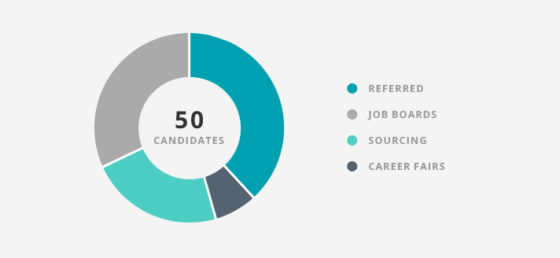Source of hire: what it is, how to measure it and how to use it
A source of hire (SoH) is a metric that shows the percentage of your overall hires that entered your pipeline from each recruiting channel or source. It helps companies allocate their recruiting resources effectively and refine their processes.

Tracking source of hire (SoH) will help you distribute your hiring resources to the most effective recruiting channels. As with every recruiting metric, measuring SoH can be complicated but fruitful. Here’s an overview of how to determine source of hire and how to work around its limitations:
Contents
What is source of hire?
Source of hire (SoH) shows what percentage of your overall hires entered your pipeline from each recruiting channel or source (e.g. job boards, referrals, direct sourcing.)
For example, imagine you’ve hired 50 people in the past six months from external sources. Data from your Applicant Tracking System (ATS) shows that 20 of them were referred (40%), 15 applied through job boards (30%), 12 were contacted through direct sourcing efforts (24%) and three came from career fairs (6%.) This distribution can be presented in a pie chart:

Companies may use this information to allocate their recruiting budget more effectively and refine their processes. At a minimum, tracking source of hire helps recruiters:
- Direct more resources to the most valuable channels. For example, based on the previous report, referrals represent a significant percentage of hires. If you don’t have a formal referral program, it may be time to create one. Or, if you already have a program, you could justify purchasing a dedicated tool to make the process more efficient and help drive more referrals.
- Drop or adjust consistently lagging sources. In our current example, career fairs seem to be the least fruitful source of hire. If they remain at the bottom of the distribution for a long time, experiment with other sources or rethink the way you screen candidates from career fairs.
How do companies measure SoH?
First determine what a “source” is. You could track individual sources (job board 1, job board 2 etc.) and/or their overall categories (e.g. job boards, referrals, agencies.) A broader taxonomy (like inbound, outbound and familiar) is useful to separate internal and external hiring. Also, decide whether you will only track hires or gather data on candidate sources too. Define what you will measure and measure it consistently.
To gather data:
- Use surveys. A common method is to ask a relevant question (e.g. “How did you find out about this position?”) on job applications. Also, companies often administer a short questionnaire to new hires (through a tool like Typeform or an in-person discussion.) For best results, compare candidate data (pre-hire) to new hire data (post-hire) to spot discrepancies. Standardize the questions you ask in surveys and account for all possible channels (even print advertising.)
- Maximize your Applicant Tracking System (ATS.) Your ATS records the source a candidate entered your pipeline from through automated tracking. Extract a report to view the distribution of candidates and hires among different sources.
- Examine web analytics. Recruiting marketing platforms (e.g. SmashFly, Symphony Talent) can help you track candidate engagement across channels. You could also assign UTM codes to your job ads when you post them on job boards or social media. Then, use Google Analytics to track how much traffic each posting brings in.
- Ask for data from all members of your recruiting team. Recruiters and sourcers may document the candidates they sourced, or engaged with, via social media. Hiring managers may also have recommended a source that could yield good hires for a role (e.g. a company that employs great developers.) Compile these different data points to paint a clearer picture of your sources of hire.
These methods aren’t mutually exclusive. Combine data from different methods to increase SoH’s accuracy.
What are the limitations of SoH?
SoH is more complicated than it seems because:
- Candidates pass through multiple sources. Sources are interdependent. The source from which candidates entered the hiring pipeline may not be the one where they initially found the job ad or even the one that persuaded them to apply. Social media networks are particularly important sources of influence that help attract candidates and get them to apply through other sources.
→ How to address this issue:
A recruitment marketing platform can give you insight into candidates’ interaction with your brand before they apply. Another idea is to complement your ATS’s reports by sending a survey to new hires. Ask various questions like:
Which source did you apply from?
How were you made aware of this job opportunity?
What most influenced your decision to consider the role?
Ask the same questions each time and cross-validate data from your collection methods for more accurate reporting.
- Focusing on hires overlooks qualified candidates who came close to getting hired. If your screening processes are effective, the eventual hire will emerge from a group of stellar candidates. Paying attention only to the source the hire came from diminishes other sources that were equally effective in attracting good candidates.
→ How to address this issue:
Track candidate sources along with sources of hire. Break down your SoH by hiring stage. For example, look into the source of qualified candidates who advanced to a first interview and source of qualified candidates who advanced to the final round.
- SoH may not always justify reallocation of resources. For example, referrals are often seen as the top source of hire. But, investing too much in them may negatively affect diversity. Similarly, your sourcing efforts may bring a lower percentage of hires, but these hires may be the highest quality or highest revenue-generating ones, who are well worth the investment.
→ How to address this issue:
Segment your data to distinguish what kind of candidate each source brings in. For example, you may find that your best engineers come from referrals, while your best marketing people come from job boards. Always track quality of hire and source of hire jointly. Also, connect recruiting metrics to other results (e.g. diversity) and experiment frequently with how you allocate resources.
- SoH may encourage bias and bias influences SoH. Imagine your hiring managers have hired a few good employees through a particular external recruiter. The recruiter’s previous success may prejudice hiring teams to always turn to them. SoH will be influenced in favor of that recruiter, but your company may be missing out on talent from other sources.
→ How to address this issue:
Aim for a diverse mix of sources when opening a requisition. Invest in training to help hiring teams combat their biases and make better hiring decisions.
Collect data carefully and always pair SoH with other metrics, like quality of hire and time to fill. That way, you will be able to extract valuable insights to help you enhance your recruiting efforts.
Frequently asked questions
- What is source of hire (SoH)?
- Source of hire (SoH) is a metric that shows the percentage of your overall hires that entered your pipeline from each recruiting channel or source, such as job boards, referrals, or direct sourcing. It helps allocate recruiting resources effectively.
- How do companies measure SoH?
- Companies measure SoH by tracking individual sources or their overall categories. They gather data through surveys, applicant tracking systems (ATS), web analytics, and input from the recruiting team. The data from different methods are combined to increase SoH's accuracy.
- What are the benefits of tracking SoH?
- Tracking SoH helps direct resources to the most valuable channels, adjust consistently lagging sources, and refine processes. It also helps in making strategic decisions about allocating the recruiting budget and improving the overall hiring process.
- What are the limitations of SoH?
- SoH can be complicated as candidates often pass through multiple sources. Focusing only on hires overlooks qualified candidates who came close to getting hired. Also, SoH may not always justify reallocation of resources, and it may encourage bias.
- How can these limitations be addressed?
- These limitations can be addressed by using a recruitment marketing platform, sending surveys to new hires, tracking candidate sources along with sources of hire, segmenting data, tracking quality of hire and source of hire jointly, and investing in bias training.



